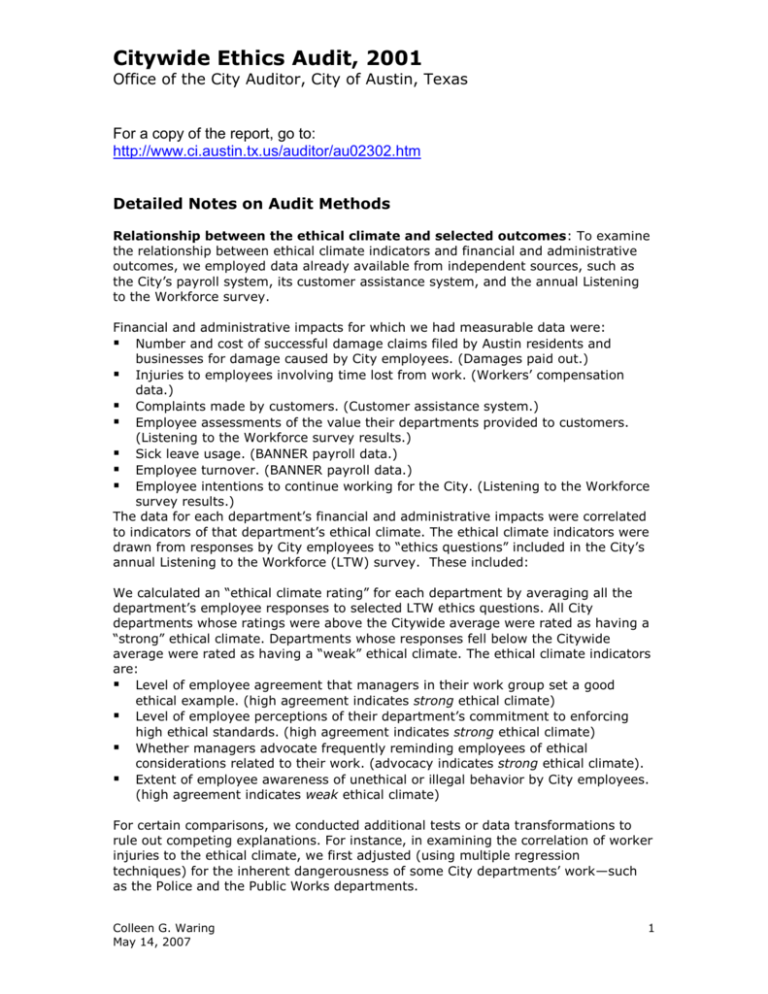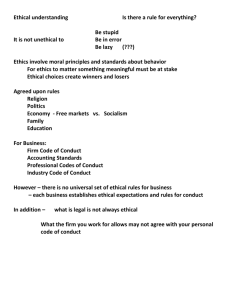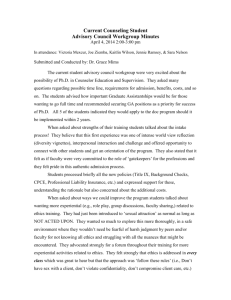Case Study - City of Austin
advertisement

Citywide Ethics Audit, 2001 Office of the City Auditor, City of Austin, Texas For a copy of the report, go to: http://www.ci.austin.tx.us/auditor/au02302.htm Detailed Notes on Audit Methods Relationship between the ethical climate and selected outcomes: To examine the relationship between ethical climate indicators and financial and administrative outcomes, we employed data already available from independent sources, such as the City’s payroll system, its customer assistance system, and the annual Listening to the Workforce survey. Financial and administrative impacts for which we had measurable data were: Number and cost of successful damage claims filed by Austin residents and businesses for damage caused by City employees. (Damages paid out.) Injuries to employees involving time lost from work. (Workers’ compensation data.) Complaints made by customers. (Customer assistance system.) Employee assessments of the value their departments provided to customers. (Listening to the Workforce survey results.) Sick leave usage. (BANNER payroll data.) Employee turnover. (BANNER payroll data.) Employee intentions to continue working for the City. (Listening to the Workforce survey results.) The data for each department’s financial and administrative impacts were correlated to indicators of that department’s ethical climate. The ethical climate indicators were drawn from responses by City employees to “ethics questions” included in the City’s annual Listening to the Workforce (LTW) survey. These included: We calculated an “ethical climate rating” for each department by averaging all the department’s employee responses to selected LTW ethics questions. All City departments whose ratings were above the Citywide average were rated as having a “strong” ethical climate. Departments whose responses fell below the Citywide average were rated as having a “weak” ethical climate. The ethical climate indicators are: Level of employee agreement that managers in their work group set a good ethical example. (high agreement indicates strong ethical climate) Level of employee perceptions of their department’s commitment to enforcing high ethical standards. (high agreement indicates strong ethical climate) Whether managers advocate frequently reminding employees of ethical considerations related to their work. (advocacy indicates strong ethical climate). Extent of employee awareness of unethical or illegal behavior by City employees. (high agreement indicates weak ethical climate) For certain comparisons, we conducted additional tests or data transformations to rule out competing explanations. For instance, in examining the correlation of worker injuries to the ethical climate, we first adjusted (using multiple regression techniques) for the inherent dangerousness of some City departments’ work—such as the Police and the Public Works departments. Colleen G. Waring May 14, 2007 1 Citywide Ethics Audit, 2001 Office of the City Auditor, City of Austin, Texas Listening to the Workforce (LTW) Questions Listening to the Workforce (LTW) surveys served as measures of outcomes from ethics management strategies and as measures of the ethical climate. Our measures represent the proportion of employees who responded with “agree” and “strongly agree” to selected questions. We used SPSS™ (Statistical Package for the Social Sciences™) software to assess the relationships. We also calculated Pearson correlation coefficients to identify linear relationships between ethical climate factors and outcomes. Ethical Climate Factors Executive leadership attention to ethics Supervisory leadership attention to ethics “Okay to deliver bad news” Efforts to detect violators Consistency between policies and practices Open discussion about ethics Freedom to question authority Fair treatment Unethical behavior punished Ethical behavior rewarded Follow-up on reports of ethics concerns Ethical Climate Outcomes Developing risks/problems are reported Awareness when issues arise Ethics integrated into decision making Employees seek advice Employee commitment Violations reported LTW Questions Colleen G. Waring May 14, 2007 Managers in my department insist that employees follow the laws and policies Managers in my department set a good example by following the laws and policies that apply to their jobs Other than in New Employee Orientation, I have participated in some type of ethics awareness training as a City of Austin employee If I become aware of unethical behavior, I know how I can report it I am familiar with the City of Austin Ethics Code I am familiar with the Administrative Bulletin on ‘Fraud, Waste, and Abuse Prevention’ If I have a complaint in my department, it will be handled fairly The City’s personnel policies are interpreted and used fairly by managers in my department The City’s personnel policies are interpreted and used fairly by the City’s Human Resources Department When changes in pay occur, I feel they are made fairly I am confident that quick and decisive action will be taken if wrongdoing is discovered in my work group Employees in my work group behave ethically in the workplace My values and the values of my department are similar I am proud to tell people that I work for the City of Austin I intend to be working for the City of Austin a year from now I have a strong commitment to the City of Austin as my employer Employees in my work group can report any unethical behavior they see without fear of retaliation 2 Citywide Ethics Audit, 2001 Office of the City Auditor, City of Austin, Texas Federal Sentencing Guidelines Comparison of City of Austin ethics management program to a standard. Using surveys, interviews, and document review, Auditors identified both citywide and departmental policies, procedures, and training materials. These were compared to the key elements of an ethics management program established in the U.S. Federal Sentencing Guidelines. Those elements were i: 1. Establish compliance standards and procedures to be followed by employees and other agents that are reasonably capable of reducing the prospect of criminal conduct. 2. Assign specific individual(s) within high-level personnel of the organization overall responsibility to oversee compliance with standards and procedures. 3. Use due care not to delegate substantial discretionary authority to individuals whom the organization knows, or should know, have a propensity to engage in illegal activity. 4. Take steps to communicate effectively the organization’s standards and procedures to employees and other agents, e.g., by requiring participation in training programs or by disseminating publications that explain in a practical manner what is required. 5. Take reasonable steps to achieve compliance with standards, e.g., by utilizing monitoring and auditing systems reasonably designed to detect criminal conduct by employees and other agents and by having in place and publicizing a reporting system whereby employees and other agents can report criminal conduct by others within the organization without fear of retribution. 6. Consistently enforce standards through appropriate disciplinary mechanisms, including, as appropriate, discipline of individuals responsible for the failure to detect an offense. Adequate discipline of individuals responsible for an offense is a necessary component of enforcement; however, the form of discipline that will be appropriate will be case specific. 7. After an offense has been detected, take reasonable steps to respond appropriately to the offense and to prevent further similar offenses — including any necessary modifications to the organization’s program to prevent and detect violations of law. i Since the 2002 audit, the U.S. Federal Sentencing Guidelines have expanded these criteria. Colleen G. Waring May 14, 2007 3








